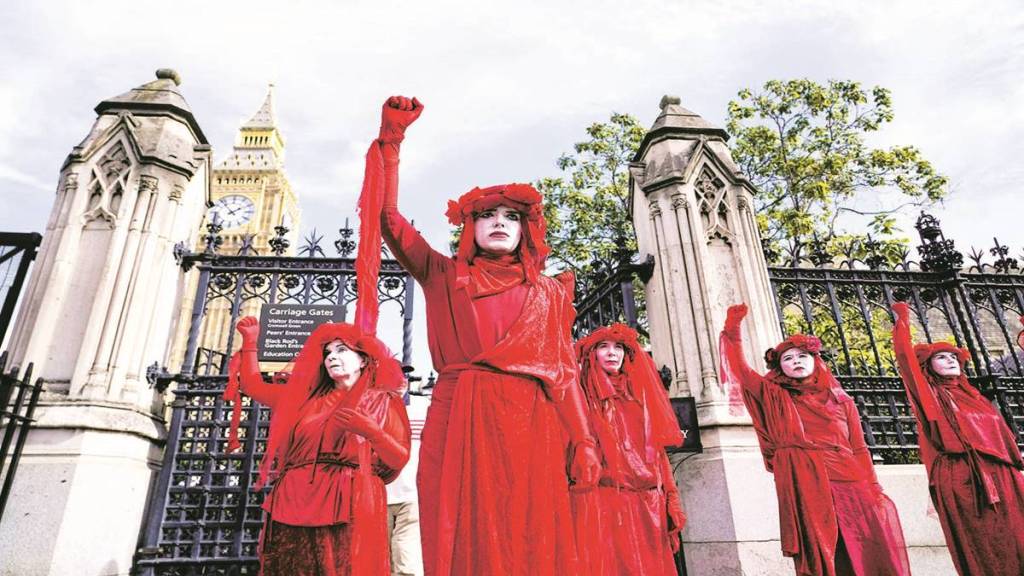Climate protesters have been disrupting world events and thronging the streets to express their anger and make bold statements in the past few months. Recently, environmental protesters caused a 49-minute delay during a semi-final game between Coco Gauff and Karolina Muchova at the US Open. Protesters had to be removed from the site in Black Rock City where Burning Man Festival is held every year in August. According to a report, this week-long festival in the desert adds 100,000 tons of CO2 to the already populated atmosphere of the US, where extreme heat made summer unbearable for many in some regions of the country, especially heat waves in Texas. Ahead of Climate Ambition Summit this week, more protesters urging the Biden administration to curb dependence on fossil fuels thronged the streets in New York.
After getting fined in July for blocking oil tankers’ passage at Malmo Harbour in Sweden during a protest against the use of fossil fuels, Greta Thunberg was once again charged for a similar offense this week. A few months ago, environment protests against a controversial irrigation project turned violent in western France’s Sainte-Soline, when clashes occurred between protesters and police. In Africa, protests were concurrent with the African Climate Summit held early this month in Nairobi, which demanded African energy be “decolonised”.
With the COP28 scheduled towards the end of November in the UAE, and the way things stand on different fronts in terms of climate action, more protests may take place in different parts of the world. The main problem is the distribution of climate finance, which is skewed towards developed countries that have available financial resources and ready infrastructure to ensure the transition to low-carbon economies.
Quite in contrast, huge disparity in the availability of climate finance has become a hindrance for several developing nations, especially countries in the Global South. Add high national debts and underdeveloped financial markets to it, and it is likely these countries’ climate ambitions shall remain distant as they have made little progress in the past seven years. Inadequate financial resources negatively impact these vulnerable countries’ ability to cope with climate-related disasters-further exacerbating inequality.
The promises made in Paris seven years ago in 2015 have so far met hurdles in the form of the distribution of climate finance. According to the Climate Policy Initiative in the last decade (2011-2020), 75% of the climate finance investments were concentrated in North America, Western Europe and East Asia & Pacific, and only 25% went to low-income and middle-income countries, and 2% to African nations.
It has been estimated that the inflow of funds from developed countries to developing countries in 2020 stood at $83.3 billion — 4% higher than the previous year. It has been widely reported some low-income countries have paid as much as 16% of their revenues for the repayment of interest on loans and thus, climate finance is a huge burden for them.
Closer to home, this year, clean energy investments in India stood at $19 billion, way below the figure of $435 billion in the US and Europe, and $184 billion in China. India is one of the world’s largest greenhouse gas emitters (ranked third in the world behind China and the US at 2411.73 MT) and
faces an uphill task of ensuring a transition to clean energies whilst meeting its growing energy demand. It remains to be seen how the country will handle its growing power consumption demand which logged growth of 16% (151.66 billion units ) in August this year.
Climate protests are a reminder that people are concerned about the future of the planet and that governments must do more in terms of climate action. According to a report by the Rainforest Network Campaign,
“The world’s 60 largest banks by assets have invested $5.5 trillion in the fossil fuel industry since the Paris accord in 2015.” Last year, these banks had invested $673 billion in petroleum and natural gas companies such as TotalEnergies, Venture Global, ConocoPhillips and Saudi Aramco. According to a Bloomberg report, global investments in low-carbon energy transition clocked $1.1 trillion last year, which is a promising figure. However, considering the majority of these investments were focused in the developing world, the growing disparity is a problem, which is yet to be addressed.
Headline-making announcements for climate action at global summits are surely not enough.

